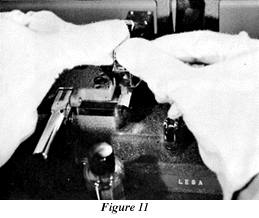
You are now ready to remove the the emulsion from the the film in the left
side, an essential step in splicing via the overlap method. The emulsion will be
removed from the left side only. 
Grip the top of the scraper firmly with the thumb and index fingers of both hands, using the base of your left hand as an anchor to help hold the splicer in place (Fig. 11). If this gripping position seems awkward, try using just one hand to control the scraper.
Lift the scraper slightly above the film and pull it to you without touching the film until the blade is just in front of the film edge. With the scraper in this position, lower it until it just touches the film. With a backward motion, scrape the film to remove the emulsion. The base of the film should be left intact. You will need to make several scrapes to get the feel of the scraper and to determine the amount of pressure needed to remove the emulsion without tearing the film. After each practice scrape, unlock the left blades and move the film forward to new cutting positions. Continue to practice until you can clean the emulsion off to the proper depth and consistency with one or two scrapes.

If the scraped area is clear, you have scraped too deeply and probably too many times.
If the surface is spotty with specks of clear and specks of emulsion, you have scraped with an uneven motion.
If the scraped area is frosted in some spots and clear in others like cords in corduroy cloth, you have scraped too deeply and with an uneven motion.
Proper scraping is done with a smooth, backward motion and the resulting area is evenly frosted from front to back. If the splicer is properly set, you should be able to clear the surface of all emulsion with one scrape, two at the most.
When you have mastered the scraping technique, it is time to apply the cement and make the splice. Since cement deteriorates rapidly, you must work swiftly to apply the cement and lock the blades before it dries.
 Film Collector's
Reference Center Film Collector's
Reference Center |